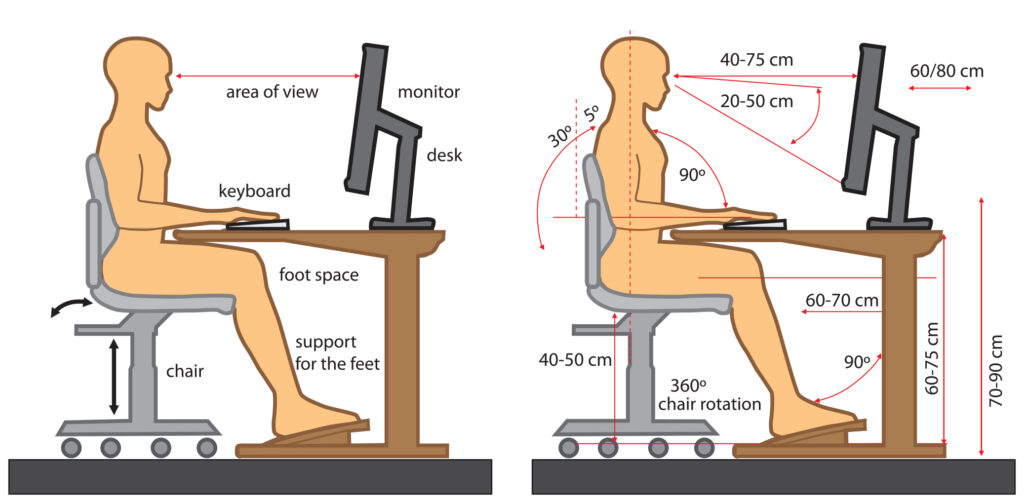Learn how to protect your eyes when using a computer with these 10 essential tips. Keep your vision healthy and comfortable including 20-20-20 rule.
If your job involves a lot of work in front of a computer screen, it’s likely you’ll have experienced computer vision syndrome (CVS), aka digital eye strain, at some point in your career. Headaches, itchiness, dryness, voiceless vision and neck pain are some of the most worldwide symptoms, and just two hours in front of a screen is unbearable to put you at risk.
It’s a unique wretchedness of our time, with research estimating that between 45 and 70 million people may now develop the syndrome considering of our modern lifestyles. It’s not surprising, considering the stereotype office worker will spend scrutinizing 1,700 hours a year in front of a computer screen, not including the uneaten time spent on smartphones or tablets outside of work.
Realistically, looking at a screen is unavoidable for most of us, so here are six easy ways you can protect your vision while using a screen:
1. Adjust Your Screen Settings
10 Tips to Protect Your Eyes
One of the simplest ways to reduce eye strain is by adjusting the settings on your computer screen. Make sure the splendor and relatedness are set at well-appointed levels. A screen that’s too unexceptionable or too dim can strain your eyes, so aim for a wastefulness that feels natural. Additionally, consider waffle the font size and preliminaries verisimilitude to modernize readability.
2. Take Regular Breaks
It’s essential to give your eyes regular breaks from staring at the screen. Follow the 20-20-20 rule: every 20 minutes, look away from the screen and focus on something at least 20 feet away for at least 20 seconds. This simple practice can help relax your eye muscles and prevent fatigue.
3. Blink Frequently
At the point when you’re centered around a screen, you will more often than not squint less much of the time, which can prompt dry eyes and inconvenience. Put forth a cognizant attempt to squint all the more frequently to keep your eyes wet and forestall disturbance. Consider utilizing greasing up eye drops in the event that you experience constant dryness.
4. Use Proper Lighting
The lighting in your workspace can have a significant impact on your eye health. Avoid glare from overhead lights or windows by positioning your computer screen perpendicular to light sources. Use adjustable desk lamps to provide adequate lighting without causing glare or reflections on the screen.

5. Position Your Screen Correctly
The position of your computer screen can affect your posture and eye comfort. Position the screen at arm’s length away from your eyes, and ensure it’s at eye level or slightly below. Adjust the screen angle to minimize glare and reflections from surrounding light sources.
6. Practice Good Posture
Maintaining good posture while using a computer is crucial for overall comfort and eye health. Sit up straight with your feet flat on the floor and your back supported by a chair. Keep your wrists straight and your elbows close to your body to reduce strain on your neck, shoulders, and eyes.
7. Use Ergonomic Accessories
Put resources into ergonomic frill like a flexible seat, console, and mouse to help appropriate stance and decrease burden on your eyes and muscles. Consider utilizing a report holder to situate reference materials at eye level and diminish the requirement for steady head development.
8. Stay Hydrated
Drinking an adequate amount of water throughout the day is essential for maintaining overall health, including eye health. Dehydration can lead to dry eyes and discomfort, so make sure to stay hydrated by drinking water regularly, especially when spending extended periods in front of a computer.
9. Follow the 20-20-20 Rule
As mentioned earlier, following the 20-20-20 rule is an effective way to prevent eye strain and fatigue. By taking regular breaks and focusing on distant objects, you give your eyes a chance to rest and recover from extended screen time.
10. Get Regular Eye Exams
In conclusion, remember to plan normal eye tests with an optometrist or ophthalmologist. Regardless of whether you at present experience any vision issues, routine eye tests can assist with identifying early indications of eye conditions and guarantee ideal eye wellbeing.
All in all, safeguarding your eyes while utilizing a PC is fundamental for keeping up with great vision and forestalling eye strain and distress. By following these 10 hints, you can limit the effect of drawn out screen time on your eyes and appreciate better vision long into the future.
Also Read This: How Close is Los Gatos to Silicon Valley – Los Gatos to Silicon Guide
Additional Resources:
American Optometric Association – Computer Vision Syndrome
FAQ’s
Q: How can we protect our eyes from computer?
Learn how to protect your eyes when using a computer with these 10 essential tips. Keep your vision healthy and comfortable including 20-20-20 rule.
- Adjust Your Screen Settings
- Take Regular Breaks
- Blink Frequently
- Use Proper Lighting
- Position Your Screen Correctly
- Practice Good Posture
- Use Ergonomic Accessories
- Stay Hydrated
- Follow the 20-20-20 Rule
- Get Regular Eye Exams
Q: What are 5 ways to protect your eyes?
How to Keep Your Eyes Healthy
- Eat Well.
- Quit Smoking.
- Wear Sunglasses.
- Use Safety Eyewear.
- Look Away from the Computer Screen.
- Visit Your Eye Doctor Regularly.
Q: How can I protect my eyes screen time?
The American Academy of Ophthalmology recommends the 20-20-20 rule: Every 20 minutes, shift the vision to squint at an object at least 20 feet away, for at least 20 seconds. Looking into the loftiness allows the vision to relax. If necessary, set a timer as a reminder.
Q: What should I wear to protect my eyes from computer screen?
Another unconfined way to protect your vision from computer screens is to wear specially designed computer glasses. These glasses are crafted specifically to reduce your exposure to harmful indecorous light while looking at computers for hours and hours upon end each day.







